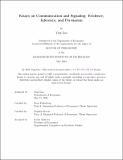Essays on Communication and Signaling: Evidence, Inference, and Persuasion
Author(s)
Gao, Ying
DownloadThesis PDF (1.568Mb)
Advisor
Fudenberg, Drew
Morris, Stephen
Terms of use
Metadata
Show full item recordAbstract
This thesis contains 3 chapters, each of which explores the implications of partial disclosure in a different context. As disclosures affect the beliefs of key actors in each scenario, optimal information design is an important consideration, and I try to characterize it and identify potential pitfalls in each case.
Chapter 1 considers the disclosure problem of a sender with a large dataset of hard evidence. A sender may have an incentive to drop observations before submitting the data to receivers in order to persuade them to take a favorable action. I predict which observations the sender discloses using a model with a continuum of data, and show that this model approximates the outcomes with large, multi-variable datasets. In the receiver's preferred equilibrium, the sender's strategy relies on imitation: they submit evidence that imitates the natural distribution under a more desirable target state. As a result, it is enough for an experiment to record data on outcomes that maximally distinguish higher states. I characterize these strategies and show that senders with little data or a favorable state fully disclose their data, but still suffer from the receiver’s skepticism, and therefore are worse-off than they are under full information. On the other hand, senders with large datasets can benefit from voluntary disclosure by dropping observations under low states.
In Chapter 2, my coauthors and I study the Federal Reserve's problem of disclosing the models it uses in supervisory stress tests of large banks. Banks argue that nondisclosure leads to inefficiencies stemming from uncertainty, but regulators are concerned that full disclosure can lead to banks gaming the system. We formalize the intuition behind this trade-off in a stylized model where both the regulator and banks have imperfect, private "models" about a risky asset, and the regulator uses its own model to `stress test' the investment. We show that if the regulator uses its model to test the banks' investment, full disclosure is suboptimal, and the regulator may benefit from hiding the model when the bank's model is more precise than the regulator's own model. The key idea is that hiding the regulator's model forces the bank to guess it using the bank's own models, effectively eliciting the bank's private information. We also show that if the regulator can fine-tune disclosure policies, the regulator can approximately enforce banks to take the first-best action, through an intuition closely related to the Cremer and McLean (1988) information rent extraction result.
Finally, in Chapter 3 I return to signaling via hard evidence, and analyze communication through a piece of verifiable evidence when the receiver/decision maker is uncertain about where the sender's preferred action lies in relation to their own, that is, the sender's relative bias. In contrast to the known-preference case, fully informative communication is impossible, even when the receiver is certain the sender is informed. The main novelty is that receivers cannot distinguish between senders of opposite preferences who pool by withholding their information when it is unfavorable. Two opposing patterns of partial disclosure emerge. When senders are biased relative to receivers, but just as state-sensitive, nondisclosure is driven by senders with extreme preferences, who choose to withhold slightly unfavorable evidence. The reverse, however, occurs when senders are state-insensitive.
JEL Codes: D80, D82, G28
Date issued
2024-05Department
Massachusetts Institute of Technology. Department of EconomicsPublisher
Massachusetts Institute of Technology